1995 CHEVROLET MONTE CARLO coolant temperature
[x] Cancel search: coolant temperaturePage 103 of 324
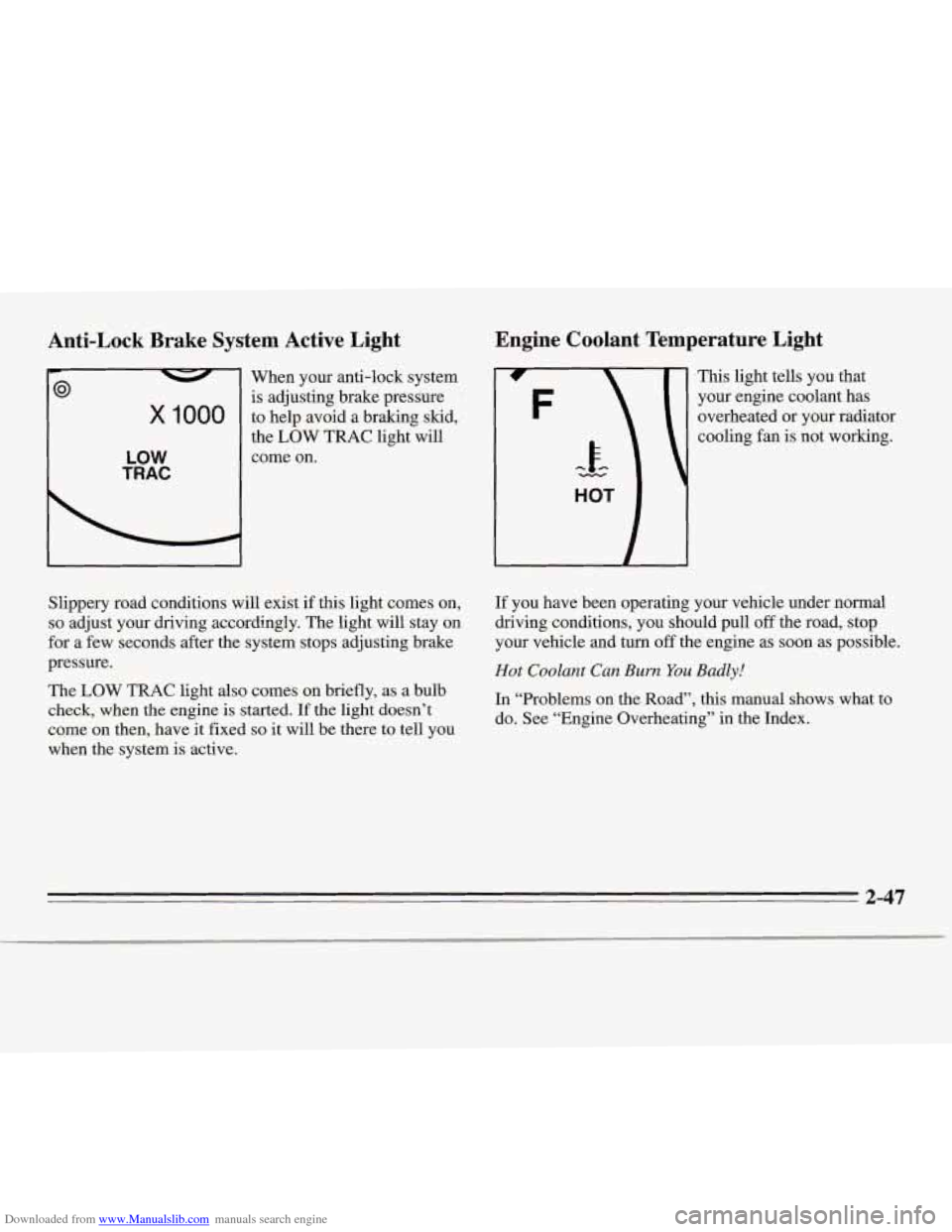
Downloaded from www.Manualslib.com manuals search engine Anti-Lock Brake System Active Light
x 1000
LOW
TRAC
When your anti-lock system
is adjusting brake pressure
to help avoid a braking skid,
the
LOW TRAC light will
come on.
Engine Coolant Temperature Light
This light tells you that
your engine coolant has
overheated
or your radiator
cooling
fan is not working.
Slippery road conditions will exist if this light comes on,
so adjust your driving accordingly. The light will stay on
for a few seconds after the system stops adjusting brake
pressure.
The
LOW TRAC light also comes on briefly, as a bulb
check, when the engine is started.
If the light doesn’t
come on then, have
it fixed so it will be there to tell you
when the system is active. If you
have been operating your vehicle under normal
driving conditions, you should pull
off the road, stop
your vehicle and
turn off the engine as soon as possible.
Hot Coolant Can Burn You Badly!
In “Problems on the Road”, this manual shows what to
do. See “Engine Overheating” in the Index.
2-47
Page 104 of 324

Downloaded from www.Manualslib.com manuals search engine Engine Coolant Temperature Gage
11 You have a gage that
100 \W0260
shows the engine coolant
temperature.
If the gage
pointer moves into the red
E-
area, your engine is too hot!
r
Low Coolant Warning Light
If this light comes on, your
system is low on coolant
and the engine may
overheat. See “Engine
Coolant” in the Index and
have your vehicle serviced
as soon as you can.
That reading means the same thing as the warning light.
It means that your engine coolant has overheated. If you
have been operating your vehicle under normal driving
conditions, you should pull
off the road, stop your
vehicle and
turn off the engine as soon as possible.
Hot Coolant Can Burn You Badly!
In “Problems on the Road”, this manual shows what to
do. See “Engine Overheating” in the Index.
2-48
Page 113 of 324
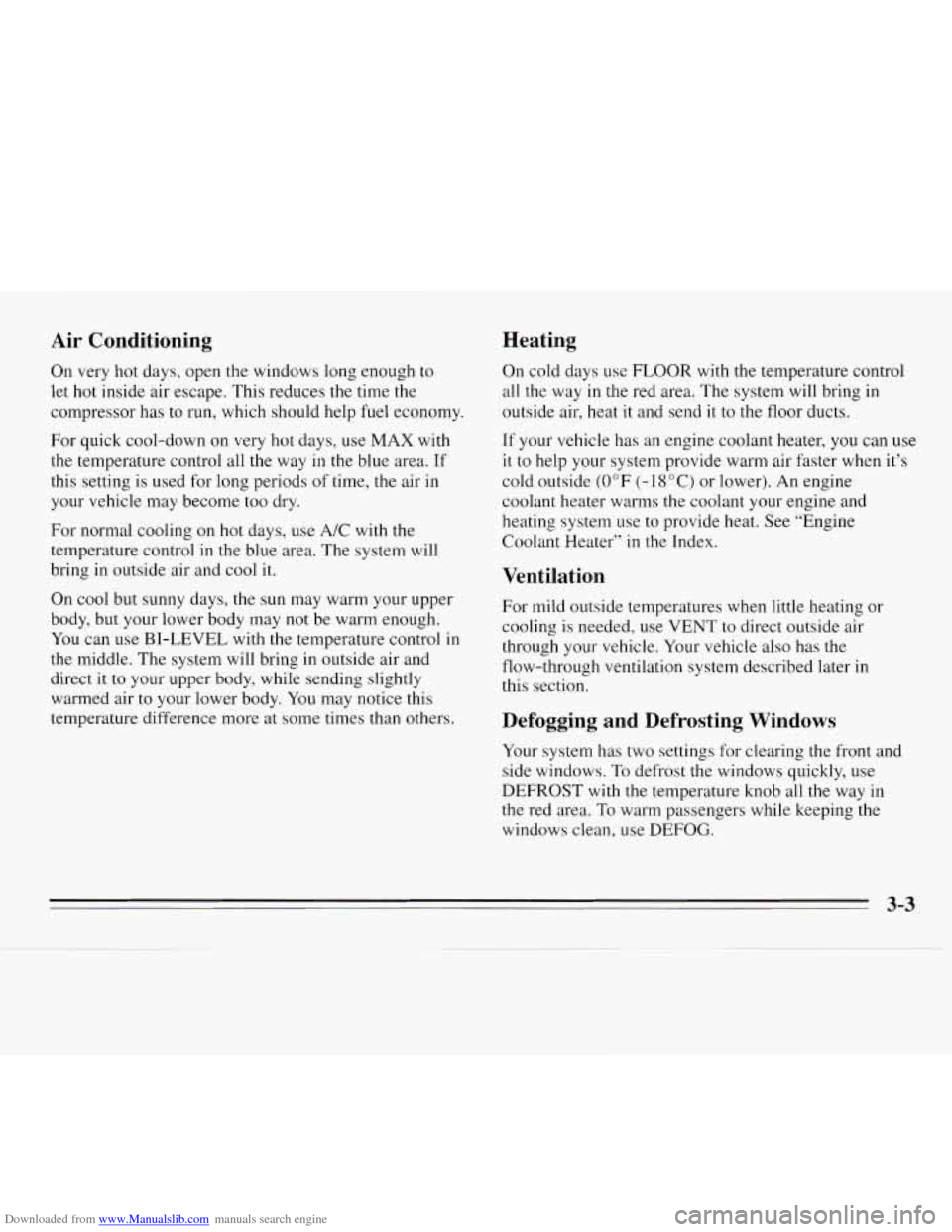
Downloaded from www.Manualslib.com manuals search engine Air Conditioning
On very hot days, open the windows long enough to
let
hot inside air escape. This reduces the time the
compressor has to run, which should help fuel economy.
For quick cool-down on very hot days, use
MAX with
the temperature control all the way in the blue area. If
this setting is used for long periods of time, the air in
your vehicle may become too dry.
Heating
For normal cooling on hot days, use A/C with the
temperature control in the blue area. The system will
bring in outside air and cool it.
On cool but sunny days, the sun may warm your upper
body, but your lower body may not be warm enough.
You can use BI-LEVEL with the temperature control in
the middle. The system will bring in outside air and
direct it to your upper body, while sending slightly
warmed air to your lower body. You may notice this
temperature difference more at some times
than others. On
cold days use FLOOR with the temperature control
all the way in the red area. The system will bring in
outside air, heat it and send it to the floor ducts.
If your vehicle has an engine coolant heater, you can use
it
to help your system provide warm air faster when it’s
cold outside
(0°F (-18°C) or lower). An engine
coolant heater warms the coolant your engine and
heating system use to provide heat. See “Engine
Coolant Heater”
in the Index.
Ventilation
For mild outside temperatures when little heating or
cooling
is needed, use VENT to direct outside air
through your vehicle. Your vehicle also has the
flow-through ventilation system described later
in
this section.
Defogging and Defrosting Windows
Your system has two settings for clearing the front and
side windows.
To defrost the windows quickly, use
DEFROST with the temperature knob all
the way in
the red area. To warm passengers while keeping the
windows clean, use
DEFOG.
3-3
Page 174 of 324
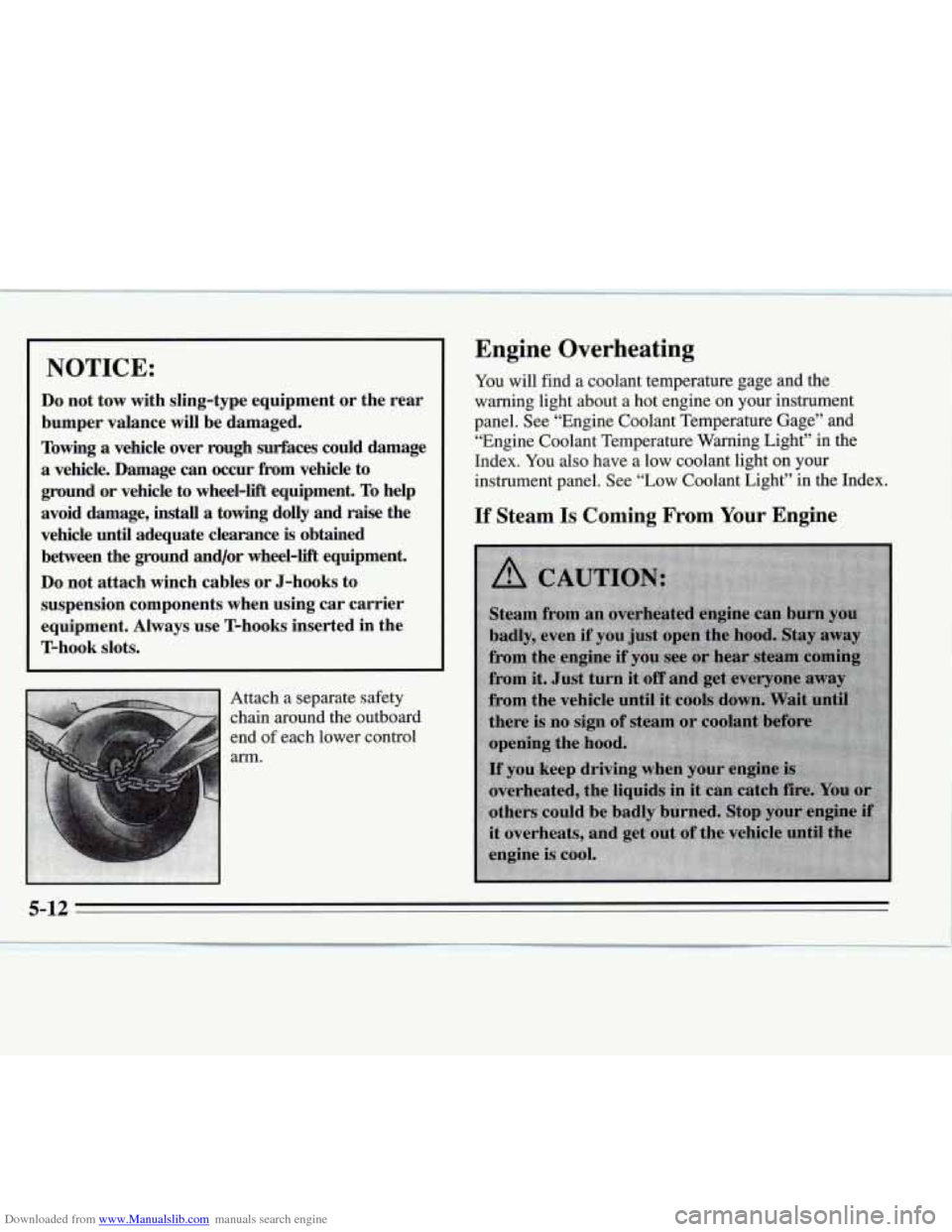
Downloaded from www.Manualslib.com manuals search engine NOTICE:
Do not tow with sling-type equipment or the rear
bumper valance
will be damaged.
Towing
a vehicle over rough surfaces could damage
a vehicle. Damage can occur hm vehicle to
ground or vehicle to wheel-lift equipment. To help
avoid damage,
install a towing dolly and raise the
vehicle until adequate clearance
is obtained
between the ground and/or wheel-lift equipment.
Do not attach winch cables or J-hooks to
suspension components when using car carrier
equipment. Always use T-hooks inserted
in the
T-hook slots.
Attach a separate safety
chain around the outboard
end
of each lower control
arm.
Engine Overheating
You will find a coolant temperature gage and the
warning light about a hot engine on your instrument
panel. See “Engine Coolant Temperature Gage” and
“Engine Coolant Temperature Warning Light” in the
Index. You
also have a low coolant light on your
instrument panel. See “Low Coolant Light” in the Index.
If Steam Is Coming From Your Engine
5-12
I I
Page 208 of 324
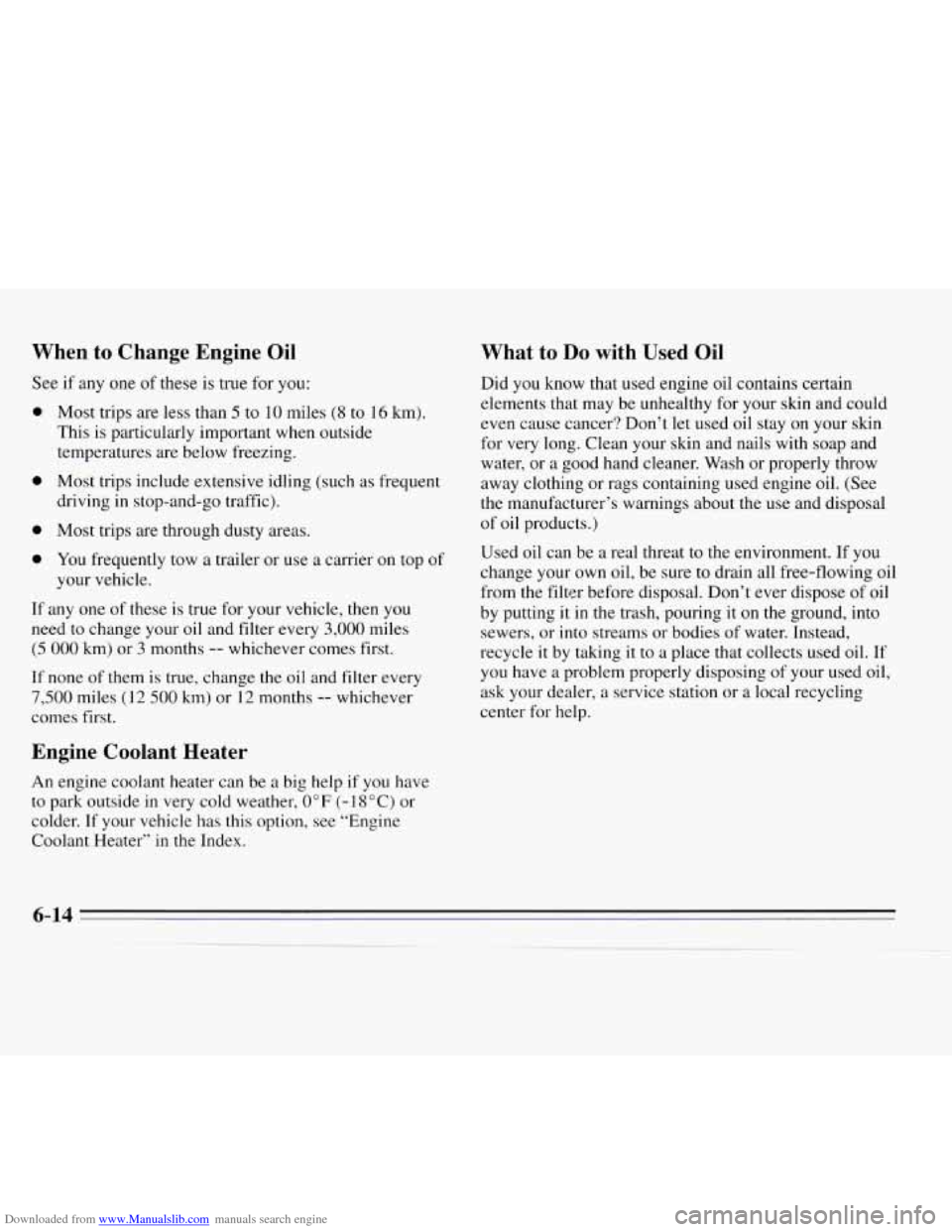
Downloaded from www.Manualslib.com manuals search engine When to Change Engine Oil
See if any one of these is true for you:
0
0
0
0
Most trips are less than 5 to 10 miles (8 to 16 km).
This is particularly important when outside
temperatures are below freezing.
Most trips include extensive idling (such as frequent
driving in stop-and-go traffic).
Most trips are through dusty areas.
You frequently tow a trailer or use
a carrier on top of
your vehicle.
If any one of these is true for your vehicle, then you
need
to change your oil and filter every 3,000 miles
(5 000 km) or 3 months -- whichever comes first.
If none of them
is true, change the oil and filter every
7,500 miles (1 2 500 km) or 12 months -- whichever
comes first.
Engine Coolant Heater
An engine coolant heater can be a big help if you have
to park outside in very cold weather,
0°F (- 18OC) or
colder. If your vehicle has this option, see “Engine
Coolant Heater”
in the Index.
What to Do with Used Oil
Did you know that used engine oil contains certain
elements that may be unhealthy for your skin and could
even cause cancer? Don’t let used oil stay on your skin
for very long. Clean your skin and nails with soap and
water, or a good hand cleaner. Wash or properly throw
away clothing or rags containing used engine oil. (See
the manufacturer’s warnings about the use and disposal
of oil products.)
Used oil can be a real threat to the environment. If you
change your own oil, be sure to drain all free-flowing oil
from the filter before disposal. Don’t ever dispose
of oil
by putting it
in the trash, pouring it on the ground, into
sewers, or into streams or bodies
of water. Instead,
recycle
it by taking it to a place that collects used oil. If
you have a problem properly disposing of your used oil,
ask your dealer, a service station or a local recycling
center for help.
Page 213 of 324

Downloaded from www.Manualslib.com manuals search engine How to Add Fluid
Refer to the Maintenance Schedule to determine what
kind of transaxle fluid to use. See “Recommended
Fluids and Lubricants” in the Index.
If the fluid level is low, add only enough of the proper
fluid
to bring the level into the cross-hatched area on the
dipstick.
1. Pull out the dipstick.
2. Using a long-neck funnel, add enough fluid at the
dipstick hole to bring it
to the proper level.
It doesn’t take much fluid, generally less than a pint
(OSL). Don’t overfill. We recommend you use only fluid
labeled DEXRON@-111, because fluid with that label is
made especially for your automatic transaxle. Damage
caused by fluid other than DEXRON@-III
is not covered
by your new vehicle warranty.
After adding fluid, recheck the fluid level as
described under “How
to Check.”
When the correct fluid level is obtained, push the
dipstick back in all the way.
Engine Coolant
The following explains your cooling system and how to
add coolant when
it is low. If you have a problem with
engine overheating or if you need to add coolant to your
radiator, see “Engine Overheating” in the Index.
The proper coolant for your Chevrolet will:
0 Give freezing protection down to -34°F (-37°C).
Give boiling protection up to 262 OF ( 128 O C).
Protect against rust and corrosion.
Help keep the proper engine temperature.
Let the warning lights work as they should.
What to Use
Use a mixture of one-half clean water (preferably
distilled) and one-half antifreeze that meets
“GM
Specification 1825-M,” which won’t damage aluminum
parts. You can also use
a recycled coolant conforming to
GM Specification 1825-M with a complete coolant flush
and refill. Use GM Engine Coolant Supplement (sealer)
with any complete coolant flush and refill. If you use
this mixture, you don’t need to add anything else.
6-19
Page 216 of 324
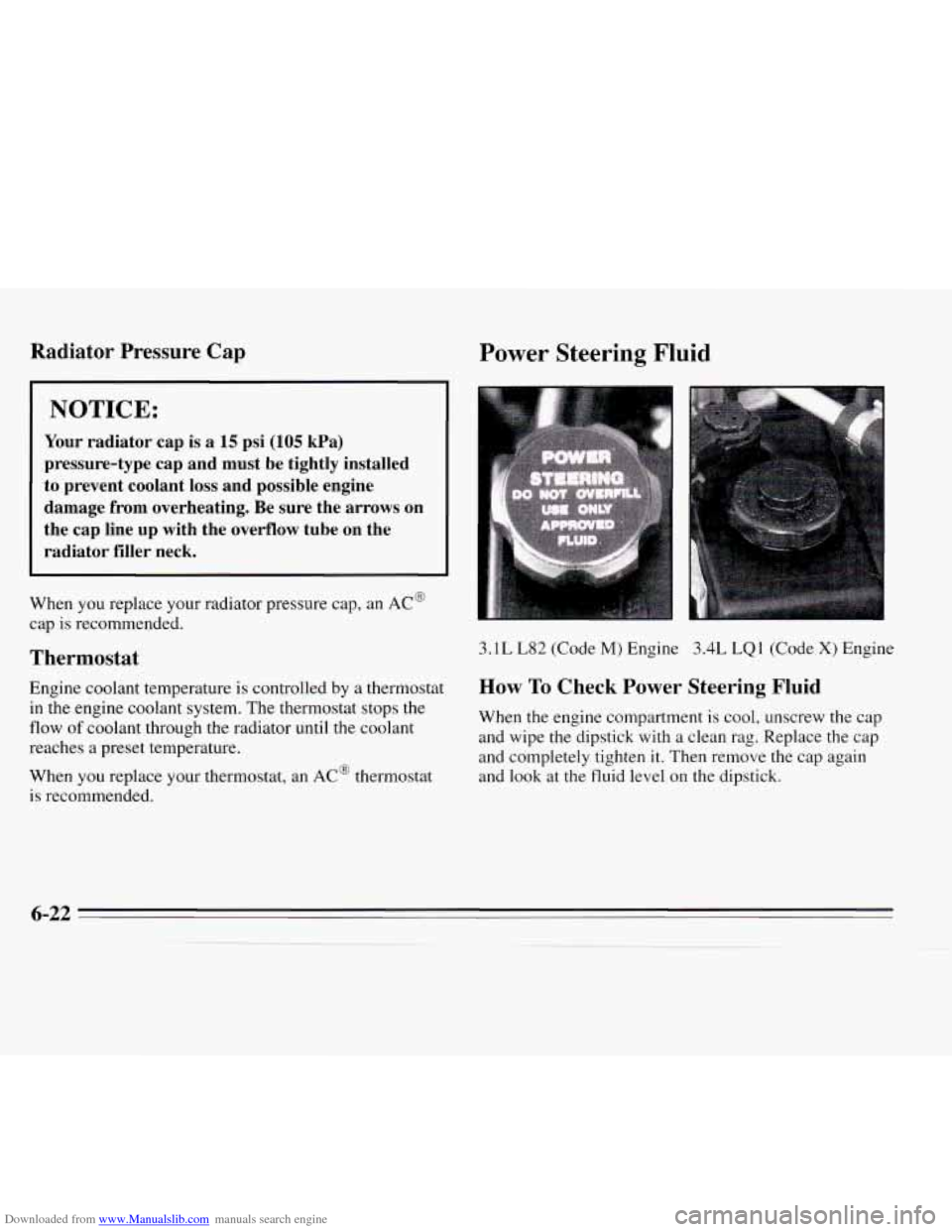
Downloaded from www.Manualslib.com manuals search engine Radiator Pressure Cap
NOTICE:
Your radiator cap is a 15 psi (105 kPa)
pressure-type cap and must be tightly installed
to prevent coolant loss and possible engine
damage from overheating. Be sure the arrows on
the cap line up with the overflow tube on the
radiator filler neck.
When you replace your radiator pressure cap, an AC@
cap is recommended.
Thermostat
Engine coolant temperature is controlled by a thermostat
in the engine coolant system.
The thermostat stops the
flow of coolant through the radiator until the coolant
reaches a preset temperature.
When you replace your thermostat, an
AC@ thermostat
is recommended.
Power Steering Fluid
3.1 L L82 (Code M) Engine 3.4L LQ 1 (Code X) Engine
How To Check Power Steering Fluid
When the engine compartment is cool, unscrew the cap
and wipe the dipstick with a clean rag. Replace the cap
and completely tighten
it. Then remove the cap again
and look at the fluid level on the dipstick.
6-22
Page 313 of 324
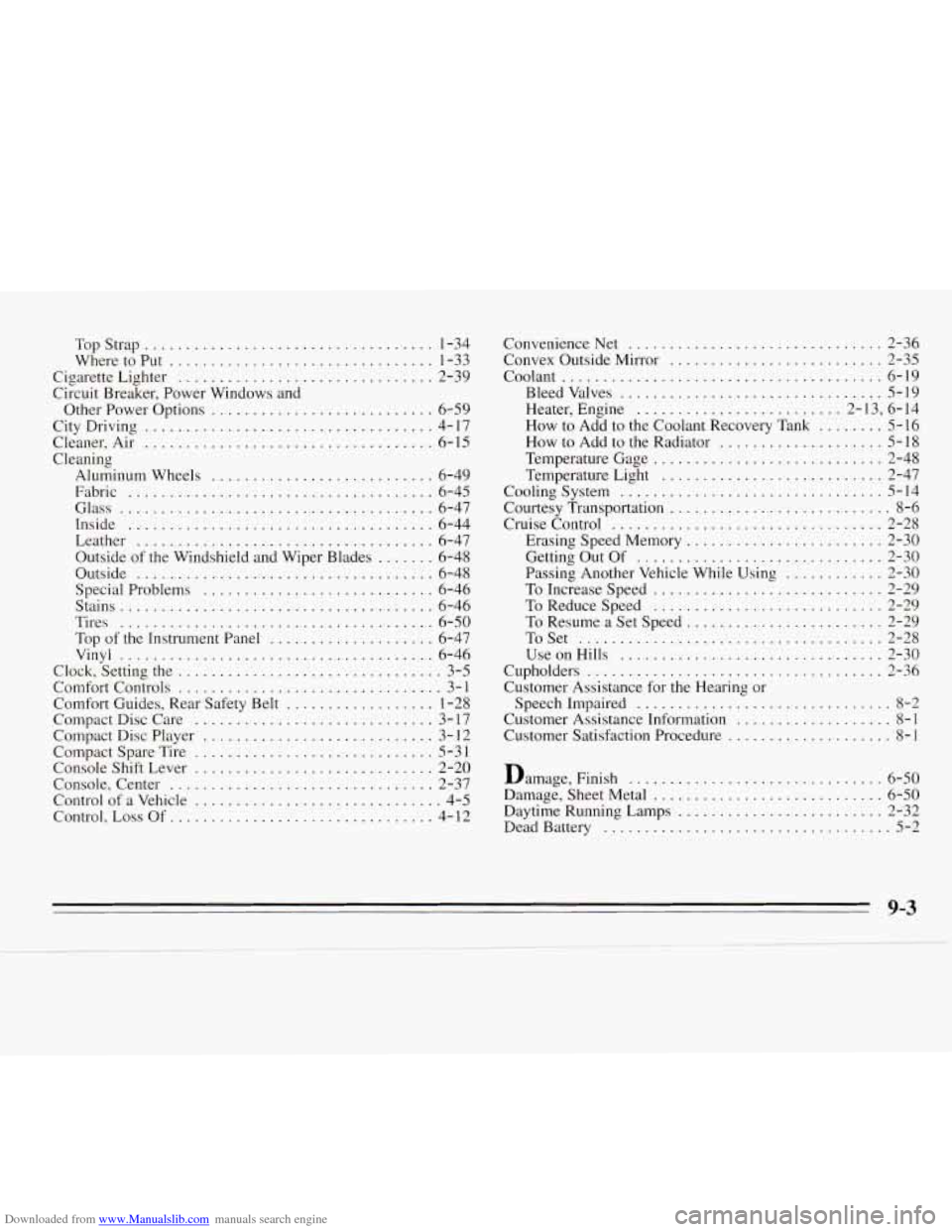
Downloaded from www.Manualslib.com manuals search engine TopStrap ................................... 1-34
WheretoPut
................................ 1-33
Cigarette Lighter
............................... 2-39
Circuit Breaker. Power Windows and
Other Power Options
........................... 6-59
City Driving
................................... 4-17
Cleaner. Air
................................... 6-15
Cleaning Aluminum Wheels
........................... 6-49
Fabric
..................................... 6-45
Glass
...................................... 6- 47
Inside ..................................... 6-44
Leather
.................................... 6-47
Outside of the Windshield and Wiper Blades
....... 6-48
Outside
.................................... 6-48
Special Problems
............................ 6-46
Stains
...................................... 6-46
Tires
...................................... 6-50
Top of the Instrument Panel
.................... 6-47
Vinyl
...................................... 6- 46
Clock, Setting
the ................................ 3-5
Comfort Controls
................................ 3- 1
Comfort Guides, Rear Safety Belt .................. 1-28
Compact Disc Care
............................. 3- 17
Compact Disc Player
............................ 3- 12
Compact Spare Tire ............................. 5-3 1
Console Shift Lever ............................. 2-20
Console, Center
................................ 2-37
Control of
a Vehicle .............................. 4-5
Control,
Loss Of ................................ 4- 12
Convenience Net ............................... 2-36
Convex Outside Mirror
.......................... 2-35
Coolant
....................................... 6-19
Bleedvalves
................................ 5-19
Heater. Engine
......................... 2-14 13. 6.
How to Add to the Coolant Recovery Tank
........ 5-16
How to Add to the Radiator
.................... 5-18
Temperature Gage
............................ 2-48
Temperature Light
........................... 2-47
Cooling System
................................ 5-14
Courtesy Transportation
........................... 8-6
Cruise Control
................................. 2-28
Erasing Speed Memory
........................ 2-30
Getting Out Of
.............................. 2-30
Passing Another Vehicle While Using
............ 2-30
To Increase Speed ............................ 2-29
ToReduceSpeed
............................ 2-29
To Resume a Set Speed ........................ 2-29
ToSet
..................................... 2-28
UseonHills
................................ 2-30
Cupholders
.................................... 2-36
Customer Assistance for the Hearing or
Speech Impaired
............................... 8-2
Customer Assistance Information
................... 8-1
Customer Satisfaction Procedure
.................... 8-1
Damage. Finish
............................... 6-50
Damage. Sheet Metal
............................ 6-50
Daytime Running Lamps
......................... 2-32
Dead Battery
................................... 5-2
9-3